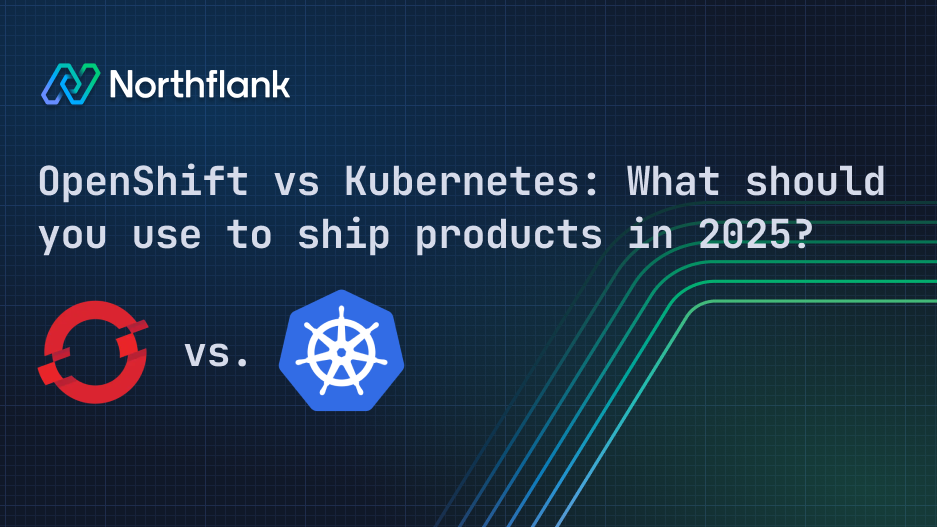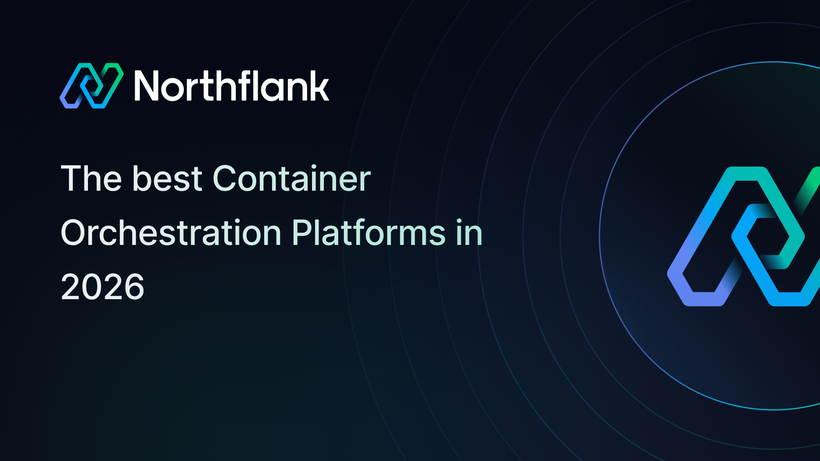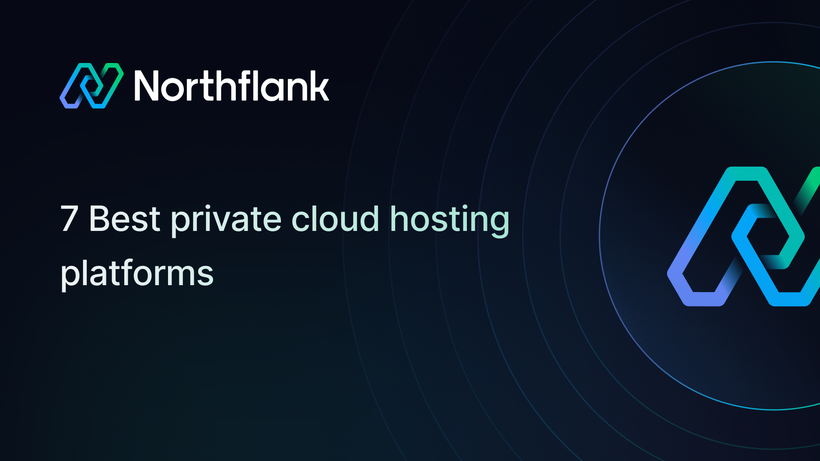

OpenShift vs Kubernetes: What should you use to ship products in 2025?
Comparing Kubernetes to OpenShift is a bit like comparing apples to oranges, or maybe more accurately, apples to an entire fruit salad.
Kubernetes isn't a platform. It's a container orchestration framework: a powerful toolkit for managing containerized workloads at scale. OpenShift builds directly on Kubernetes but wraps it in an enterprise-ready package. It simplifies many operational tasks but inevitably sacrifices flexibility.
When deciding between Kubernetes and OpenShift, teams face a key trade-off: total control versus ease-of-use. Kubernetes offers deep configurability but comes with substantial complexity, while OpenShift provides structured simplicity but imposes rigid workflows.
But what if you didn't need to compromise?

Kubernetes was never designed to be simple. It was built to solve complex infrastructure problems at the scale of Google. What that means in practice is a system composed of dozens of moving parts: pods, nodes, controllers, CRDs, operators, and so on. Every piece can be customized, extended, and tuned. That power is what makes Kubernetes the de facto standard, but also what makes it hard to use.
Setting up a working Kubernetes environment isn't just about installing it. You need to provision a cluster, configure ingress, manage secrets, set up network policies, configure storage classes, integrate observability tools, enforce RBAC, and stitch together CI/CD workflows. That's before you even deploy your actual application.
Even managed services like GKE, EKS, or AKS offload only part of that burden. You still need to be an infrastructure engineer to operate it well. Kubernetes doesn't give you batteries included. It gives you an instruction manual for building your own power grid.
Kubernetes stands out for:
- Customization: Kubernetes gives users extensive control to adapt it precisely to their needs.
- Portability: It's cloud-agnostic, enabling migration of workloads across clouds and on-premise infrastructures.
- Community and ecosystem: With broad community support, numerous resources, plugins, and extensions, Kubernetes enjoys unparalleled ecosystem backing.
Kubernetes' complexity comes with several challenges:
- Steep learning curve: Initial setup and ongoing management require deep technical expertise.
- Operational overhead: Running Kubernetes clusters involves considerable operational burden, often requiring dedicated DevOps teams.
- Integration complexity: Essential functionalities, including CI/CD pipelines, security enforcement, and monitoring, require manual integration.

Developed by Red Hat, OpenShift extends Kubernetes by incorporating enterprise-grade tools and structured workflows. It's positioned as Kubernetes made simpler, targeted at organizations that need comprehensive solutions straight out of the box.
OpenShift integrates continuous integration and delivery (CI/CD), built-in security policies, compliance features, monitoring, and logging. Its structured workflows reduce setup and operational complexity significantly.
Teams usually adopt it because they're already embedded in the Red Hat ecosystem or have specific compliance requirements that make OpenShift the safe choice.


OpenShift offers:
- Integrated solutions: CI/CD pipelines, security frameworks, and observability reduce the need for additional integrations.
- Ease-of-use: Structured workflows simplify managing complex deployments and enforcing best practices.
- Red Hat support: Robust, enterprise-grade support provides peace of mind for organizations needing reliability and accountability.
While Red Hat’s messaging frames OpenShift as a full platform for modern app development, there are blind spots. OpenShift is essentially a Kubernetes distribution.
It manages orchestration and infrastructure well, but falls short when it comes to the application layer. It doesn’t help teams figure out how to build, test, and ship applications—just how to run them. It’s surprisingly unopinionated where it matters.
And it’s not easy to operate. OpenShift's operational burden is significant: standing up a cluster requires deep knowledge of IPI/UPI installs; upgrades are painful and often break CRDs or Operators unless done in strict version sequences; observability tooling is your responsibility to maintain; and backup/recovery is DIY (typically handled through tools like Velero).
On top of that, it demands a heavy VM or bare-metal footprint, especially for control plane nodes. All of this adds up to an expensive and fragile setup that’s overkill for many teams.
The developer experience isn’t much better. The UX is too complex, and often assumes the user is an infra engineer, not a developer trying to ship a service.
In addition:
- Flexibility constraints: Its structured nature limits customization and can feel restrictive for developers seeking full control.
- Higher costs: Subscription fees for licenses and support increase operational costs considerably compared to open-source Kubernetes.
- Vendor lock-in risks: OpenShift ties users closely to the Red Hat ecosystem, potentially creating dependency.
See more OpenShift alternatives here.
To provide clarity, let's examine Kubernetes and OpenShift side by side:
| Feature | Kubernetes | OpenShift |
|---|---|---|
| Complexity | High; requires deep operational expertise | Moderate; designed for simpler operations |
| Flexibility | Very High; customizable in detail | Moderate; structured, prescriptive workflows |
| Integrated CI/CD | No; external tools needed | Yes; built-in pipelines |
| Security & compliance | Manual configuration and integrations needed | Built-in enterprise-level security and compliance |
| Cost | Lower (open-source); costs from tools/support | Higher; subscription-based licensing |
| Support & reliability | Community-based or via cloud vendors | Robust enterprise support via Red Hat |

Kubernetes is overpowered for most developers. It's a low-level abstraction that was never intended to be user-friendly. OpenShift attempts to solve this by wrapping Kubernetes in a friendlier UI and opinionated tooling, but it swings too far in the other direction.
Northflank sits in the middle. It doesn't try to reinvent Kubernetes, nor does it hide it. Instead, it makes Kubernetes accessible by abstracting complexity where it matters, while still allowing teams to access the underlying primitives when they need to. This balance is what makes Northflank stand out as a real alternative to OpenShift.
Northflank addresses the limitations and builds on the strengths of both Kubernetes and OpenShift. As a fully managed Workload Delivery Platform, Northflank combines Kubernetes' flexibility with OpenShift's ease of operation.
Northflank is opinionated about one thing: you should only care about your workloads.
The rest, provisioning infrastructure, stitching together observability, setting up CI/CD, is handled for you, with sane defaults. But if you want to go deep, you can. Every deployment can be customized, every service tweaked. You can bring your own cloud, plug into your own registry, and define how jobs run. Unlike OpenShift, Northflank doesn't force you to do things a specific way, it just makes the path of least resistance the right one.
Northflank retains Kubernetes' flexibility, empowering users to design custom workflows, integrate preferred tooling, and adjust their operational setups easily. It eliminates Kubernetes' daunting operational overhead by providing managed solutions for common pain points like CI/CD integration, logging, monitoring, and security.
Enterprise features usually come at the cost of flexibility. OpenShift is a clear example of this—comprehensive in scope but rigid in execution. Northflank takes a different stance. It delivers the security, compliance, and multi-cloud capabilities enterprises expect, but without imposing a heavy-handed architecture or forcing teams into specific workflows. You get serious infrastructure without the vendor gravity well.
Most OpenShift alternatives fall into two categories: they're either raw Kubernetes management layers (like Rancher or Tanzu), or they're managed services tightly coupled to a cloud provider (like GKE or EKS). Northflank offers a third path: full workload lifecycle automation across any environment, with a platform-first experience that developers actually enjoy using.
It doesn’t just support Kubernetes, it elevates it with smart defaults, templated deployments, and a dev-friendly abstraction that doesn’t sacrifice power.
- Developer efficiency: Northflank's intuitive UI and CLI simplify operations, reducing the Kubernetes learning curve.
- Advanced security and compliance: Built-in security measures rival OpenShift's, without vendor lock-in concerns.
- Cost-efficiency: Competitive pricing provides excellent value compared to the substantial costs of OpenShift licenses.
- Operational Simplicity: Reduces the need for extensive DevOps teams by automating and simplifying routine tasks.
Red Hat OpenShift bundles dozens of open-source tools under one roof:
- CI/CD via Tekton or Jenkins
- Monitoring via Prometheus
- Logging via Fluentd or Loki
- Image builds via Source-to-Image, and so on.
While these integrations are tested and validated by Red Hat, they are still distinct, separately maintained tools that need to be upgraded, patched, and occasionally debugged in isolation.
It’s more of a toolkit than a platform. You still operate Tekton. You still manage Prometheus. You still have to understand how each component works and what to do when they don’t. Red Hat helps by standardizing integrations, but it doesn’t eliminate the complexity. In fact, it often adds another layer on top with its Operator Lifecycle Manager and various Red Hat-specific interfaces.
Northflank takes a fundamentally different approach. Instead of handing you a set of tools and expecting you to figure out how they work together, it provides a fully integrated, purpose-built platform. CI/CD is just there. Observability is built-in. Secrets, services, environments, jobs, deployment workflows, they're all part of the same cohesive system, designed to work together seamlessly.
Northflank devlivers outcomes: deployments that work, metrics that are useful, pipelines that don’t need babysitting. You don’t need to know what’s under the hood unless you want to.
This is the difference between an orchestrated toolchain and a product. OpenShift gives you a stack to manage. Northflank gives you a platform that just works out of the box.
Northflank is particularly beneficial for:
- Startups and SMEs that have outgrown basic container management tools but lack resources for complex Kubernetes setups.
- Enterprise teams looking for Kubernetes-level flexibility without sacrificing compliance or ease of use.
- Organizations wishing to avoid vendor lock-in risks posed by traditional enterprise solutions.
If you're choosing between Kubernetes and OpenShift, you're really choosing between two extremes: raw power with zero guardrails, or guardrails so thick you forget you're even using Kubernetes. Neither feels particularly modern.
Northflank offers a way out of that false binary. It's for teams that want power and speed, flexibility and guidance. It’s Kubernetes, minus the hair-pulling. It’s what OpenShift could have been if it had been designed for developers first, not enterprise procurement teams.
If you're tired of wrestling YAML but don't want to give up control, Northflank gives you a platform that just works, until you want to tinker. And when you do, it gets out of your way. That’s the path forward.



